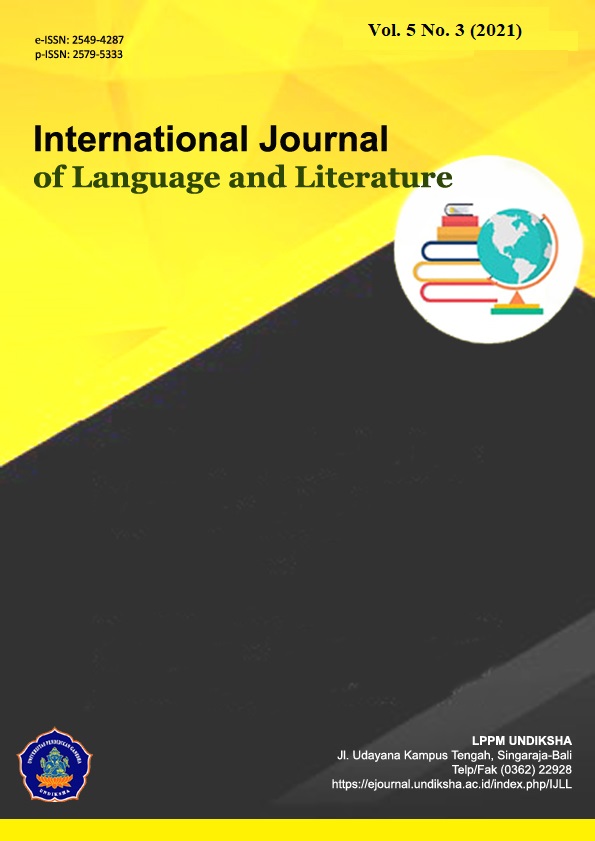THE LANGUAGE STYLE USED IN PRESENTATION ON YOUTUBE BY ENGLISH LANGUAGE EDUCATION STUDENTS
DOI:
https://doi.org/10.23887/ijll.v5i3.36215Keywords:
language style, YouTube, university studentsAbstract
People's thoughts on a particular topic were represented through language style. This study aimed at investigating kinds and functions of language style that students use when giving presentations on YouTube. There were a total of 15 students who took part in the study. A descriptive qualitative design was used in this study. The observation sheet and table classification of the types of language styles were used as research instruments. The findings revealed that concrete word (14%), abstract word (32%), general word (4%), specific word (4%), and scientific word (10%) were used in the language style based on diction. Meanwhile, antithesis (10%), repetition (10%), climax (12%), and anticlimax (4%) were among the language style based on sentence structure. Abstract word and climax made prominent appearances in both classifications, according to both data. The functions of the language style were expressive (18%), directive (43%), referential (17%), metalinguistic (7%), and phatic (15%). It suggested that directive had the most prominent expressions.
References
Buhler, K. (2011). Theory of Language: The Representational Function of Language.Amsterdam: Philadelphia. John BenjaminsPub.Co. DOI: https://doi.org/10.1075/z.164
Castillo, J. M. D. (2015). The Speech Act as an Act of Knowing. International Journal of Language and Linguistics, 3 (6), 31-38. doi: 10.11648/j.ijll.s.2015030601.15 DOI: https://doi.org/10.11648/j.ijll.s.2015030601.15
Dafirah, Kusuma, N. W., Suarka, N., Pudentia. (2019). Language Style OfDidekText In The Islands Of Selayar, South Sulawesi Province. e-Journal of Linguistics, 9 (2), 41-50.
Dolan, R. (2017). Effective Presentation Skills.Journals Investing in Science, 364 (24), 1-3. DOI: https://doi.org/10.1093/femsle/fnx235
Gudu, B. O. (2015). Teaching Speaking Skills in English Language using Classroom Activities in Secondary School Level in Eldoret Municipality, Kenya.Journal of Education and Practice, 6(35), 55-63.
Gunawan, F., Mayasari, R., Muna, W., &Masruddin, M. (2019).Lecturer’s Language Style and Students’ Academic Self Efficacy in Higher Education of Indonesia.Arab World English Journal (AWEJ), 10 (2), 77-87. DOI: https://doi.org/10.24093/awej/vol10no2.7
Holmes, J. (2001). Introduction to Sociolinguistics. Harlow, Essex: Longman
Keraf, G. (2002). Diksidan Gaya Bahaya. Jakarta: PustakaUtama.
Keraf, G. (2010). Diksidan Gaya Bahasa. Jakarta: Gramedia.
Landrum, A. R., Olshansky, A. Richards, O. (2021). Differential Susceptibility to Misleading Fat Earth Arguments on YouTube. Media Psychology, 24 (1), 136-165. DOI: https://doi.org/10.1080/15213269.2019.1669461
Miles, M. B., &Huberman. A. M. (1994). Qualitative Data Analysis (2nded). SAGE Publication Inc.
Nurhakim, Syarfuni, Sasmayunita, Thahir, A., Wahyuni, S., &Sibua, S. (2021). Speaking Students’ Improvement through Critical Thinking Concepts and YouTube Media. Psychology and Education, 58(2), 9042-9049.
Seken, I K. (2017).Introduction to Linguistics: A Reference for Language Teaching. Depok: Rajawali Pers.
Sipahutar, IY. (2018). Language Style in Love Rosie Movie: A SociolinguisticAnalysis. Universitas Sumatera Utara.
Susatyo, B &Wardono, A. (2019).Study of Language Style in Hillary Clinton’sSpeech.English Education Department of UGM. DOI: https://doi.org/10.30587/jetlal.v3i1.785
Downloads
Published
How to Cite
Issue
Section
License
IJLL Journal provides immediate open access to its content on the principle that making research freely available to the public to supports a greater global exchange of knowledge.

This work is licensed under a Creative Commons Attribution-ShareAlike 4.0 International License








